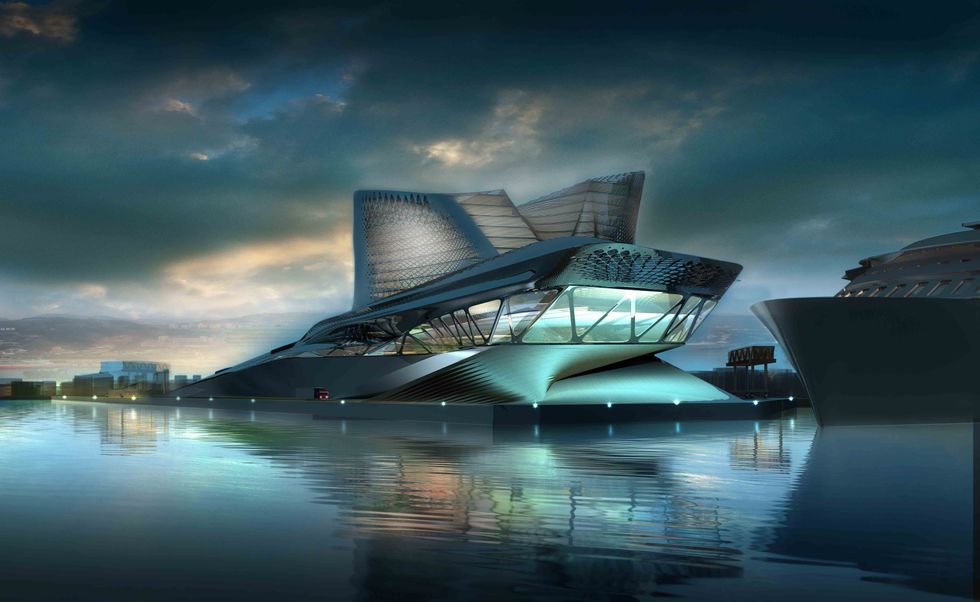"One of the great but often unmentioned causes of both happiness and misery is the quality of our environment: the kinds of walls, chairs, buildings, and streets that surround us." (Alain de Botton - The Architecture of Happiness)
Alain de Botton explains in beautiful detail the important influence architecture has in our lives and that we as human beings are dictated by our surroundings. The color on the walls can drastically change our moods, the arrangement of chairs in our living rooms can alter our social perspective, and the interior design of our personal spaces can remind us of the values and interests that we embody. At San Diego State University and the area surrounding it, there consists of many diverse aspects of architectural beauty that touch us and connect with us on these levels of human characteristics.
Being alone in a space that has enough architectural aesthetic to be noticed, appreciated, and criticized, can shape one's future aspirations and their direction and tendency to fulfill those goals. Take, for example, the interior design of the dorms on campus. The dull brick walls and the dirty vintage carpet of the Olmeca dorm building really sucks the living soul out of anyone who is unfortunate enough to live there (me). The small space of the rooms, provides very little room for construction of personal marks in its design, and despite efforts in attempting to offset the dullness of the room with posters and Christmas lights, the claustrophobic-like area makes it difficult to get work done and be happy. In contrast, the beautiful terrace of Storm Hall offers a more welcoming atmosphere for solitary endeavors. It's clear silver steel columns and clean chairs, provide a setting capable of elevating one's sense of fulfillment and one's tendency to work towards their goals. The terrace accomplishes this by isolating its architectural foundation from the rest of the campus. It's heightened location offers us a pleasant view to accompany our active and solitary states and in conjunction with its artistic aspects, the terrace refreshes us from the progressive life we live in and reminds us of who we are and what our purpose is.
The importance of the quality of our surroundings can also be interpreted and observed in a more social context. The outstanding aspects and subtle arrangements of a place that is accustomed and designed for social gatherings can alter the very pace and tone of those social activities. The Student Union on campus serves as a haven that unifies students' sense of pride for SDSU. Its multiple floors of clean halls furnished with modern couches and chairs, support movement and represent a complex community for Aztecs and its overlooking clock tower gives students a strong aura of security and upmost pride. The Architect's purpose in building the union is to unify and empower the students of SDSU and to remind them why they happily chose that school. In comparison, a fraternity house embodies the same empowerment and unity, but within a brotherhood. Its chapter room represents the secrecy the brotherhood holds responsible for, and the values the fraternity was founded upon. The holes in the walls, the piece of wood that was once a door, and the empty beer cans lying on the floor within the hallways of the house, give the brothers a history of its social interactions and reminds them of the harmonious personalities that they embody as brothers. In addition, the empty common rooms upstairs present a more lackluster atmosphere, only consisting of old couchs, grey walls, and a pleasant beige fur rug. The lackluster of aesthetics in the room, signifies that it is not designed to facilitate and foster the individual, but rather serve as a canvas for social action. The emptiness of architectural beauty welcomes different artistic tastes that the brothers of the fraternity exhibit. It is only in a social context where the artistic value of our settings has less of an influence than in an individual context, because it is in a communal setting, where we as human beings serve as the aesthetics for the architectural template.
By observing our surroundings and our reaction towards its aspects, we can really see and make sense of Alain De Botton's philosophy on architecture. Whether it is in a solitary or a social context, the quality of our environments dictate who we are and who we want to be. As we progress into a more modern era that depreciates artistic values, we must hold true to our surroundings and learn to appreciate its architectural beauty as it is to remind us of our identities and its influence to the human experience.

















